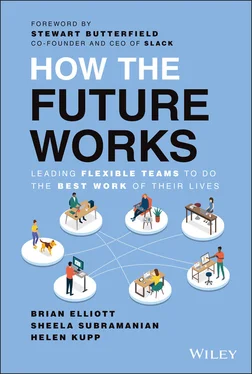Brian Elliott - How the Future Works
Здесь есть возможность читать онлайн «Brian Elliott - How the Future Works» — ознакомительный отрывок электронной книги совершенно бесплатно, а после прочтения отрывка купить полную версию. В некоторых случаях можно слушать аудио, скачать через торрент в формате fb2 и присутствует краткое содержание. Жанр: unrecognised, на английском языке. Описание произведения, (предисловие) а так же отзывы посетителей доступны на портале библиотеки ЛибКат.
- Название:How the Future Works
- Автор:
- Жанр:
- Год:неизвестен
- ISBN:нет данных
- Рейтинг книги:5 / 5. Голосов: 1
-
Избранное:Добавить в избранное
- Отзывы:
-
Ваша оценка:
- 100
- 1
- 2
- 3
- 4
- 5
How the Future Works: краткое содержание, описание и аннотация
Предлагаем к чтению аннотацию, описание, краткое содержание или предисловие (зависит от того, что написал сам автор книги «How the Future Works»). Если вы не нашли необходимую информацию о книге — напишите в комментариях, мы постараемся отыскать её.
when
where
How the Future Works: Leading Flexible Teams to Do The Best Work of Their Lives
How the Future Works
How the Future Works
How the Future Works — читать онлайн ознакомительный отрывок
Ниже представлен текст книги, разбитый по страницам. Система сохранения места последней прочитанной страницы, позволяет с удобством читать онлайн бесплатно книгу «How the Future Works», без необходимости каждый раз заново искать на чём Вы остановились. Поставьте закладку, и сможете в любой момент перейти на страницу, на которой закончили чтение.
Интервал:
Закладка:
1) Win the Battle for Talent
As we mentioned in the last chapter, in 2021 the top concerns for CEOs centered on people. As the authors of a Fortune/Deloitte CEO survey put it: “When asked about the biggest challenge they face today, CEOs named one above all others: talent, in nearly every form. Attracting, hiring, retaining, developing, growing, and engaging talent.” 3In fact, winning the battle for talent may be the most common reason companies adopt flexible work programs. As Helena Gottschling, Chief HR Officer for the Royal Bank of Canada, put it when talking about their flexible work model (something we'll look at more closely in the next chapter), “If done right, we believe it could be a true differentiator.”
First, let's look at how it can help with an organization's recruitingefforts. There's really no way around it: When employees work in an office, they must live within a commutable distance from that office. This limits the talent pool that organizations can draw from. It's also one of the main reasons that companies locate their offices in dense (and often expensive) urban markets, where there are more potential employees to choose from. But flexible work allows you to simply choose the best person for the job regardless of location. It opens up possibilities for both employees and companies. Tracy Layney, Chief Human Resources Officer at Levi Strauss & Co., is located in the Bay Area, but the vast majority of her leadership team is not—a situation she's quite happy with. “I just want the best talent,” she told us. “There's all this amazing talent in the world, so why would I want to narrow my choices to people who already live here or are willing to move to a place with a super high cost of living?”
There's also the fact that more people are looking for flexibility, so it's a real draw for companies, and it's an area where they can see an immediate impact. Soon after instituting their flexible work model, Dropbox began receiving three times the number of job applicants that they had gotten previously. We have seen similar benefits at Slack: a 70% increase in job applicants in Product, Design and Engineering after the company allowed for location flexibility.
Because people are looking for flexibility, particularly schedule flexibility, it's a model for retainingtalent as well. In fact, flexibility ranks second only to compensation in determining job satisfaction. 4That's because it provides real benefits to workers on a personal level. Research shows that flexible work leads to markedly less stress (six times less with schedule flexibility), a better work-life balance (45% higher), and better overall satisfaction at work (30% higher). And schedule flexibility can be a lifeline for those juggling responsibilities outside of work. The tug of caregiving responsibilities impacts three out of four workers, according to a Harvard Business School study. 5Those responsibilities can impact job performance and even force some people out the door. But flexible work options can be a game-changer for caregivers. Women with kids, for example, say that the number-one benefit of a flexible schedule is “being better able to take care of personal or family obligations during the day.” (Men with kids rate “better work-life balance” as the key benefit.) 6
Flexibility gives individuals room to meet both their personal and professional obligations. That's important because, as all leaders know, replacing employees is a time-consuming and costly endeavor, one that can amount to as much as twice an employee's annual salary. 7
2) Engage Employees
Every year Gallup conducts their State of the Global Workplace report, and every year it points to the same problem: a majority of employees are either not engaged or actively disengaged at work. It's an area where most companies are continually looking to improve because disengagement is expensive. 8But there is something that has been shown to have a positive impact: flexible work. Before the pandemic employees with at least some flexibility had the highest levels of engagement according to Gallup. That percentage actually rose to its highest point in 2020, 9despite all the disruptions that the pandemic brought, and the flexible work models that were imposed on companies were likely a big part of that.
One of the ways in which flexibility engages people is through inclusion, by making it easier for all kinds of people to participate and feel valued. Flexible work has the advantage of benefiting and supporting those who are commonly left out or sidelined in traditional work structures, which includes groups who have been historically discriminated against (as we'll outline in greater detail later in the book). Flexibility also benefits others who don't fit well into typical corporate structures. For example, Helen finds that flexible work better suits her introverted personality. Remote workers and those in satellite offices are more examples of groups that have traditionally been left behind. Their inability to participate fully in team events or meetings have left many feeling like second-class citizens. But when your meeting takes place in a digital space, everyone has an equal opportunity to participate. These are just a few examples, but there are many more ways in which individual employees can get left out, not because of the quality of their work or ideas, but because of things that should be far less important—like what they look like, how loudly they speak, or where they're located. Flexible work allows companies to intentionally design formats for collaborating, creating, and innovating that are a better fit for all their people.
Flexible work can also lead to better creativity and innovation, even though leaders often express concerns that it will inhibit these things that are so crucial to growth. Future Forum research shows this concern is a myth, and in fact where people work has little bearing on how creative their team is (more on this in Step 5). To give one example, there's a persistent myth that the best method is to gather people in a room and brainstorm your way to new ideas. Companies have been doing this for decades, but countless studies have shown that this approach is a waste of time, at best; at worst it can lead to the dreaded groupthink and even harm productivity. 10
3) Build Better Results
Because it has a positive effect on common business challenges, like recruiting and retention; because it leads to happier, less stressed, and more engaged employees; because of these things and more, flexible work, when done right, quite simply drives better business results.
And yet leaders regularly have concerns. One of the most common ones is that flexible work will negatively impact productivity. Some version of the following question comes up often: “If my team members aren't in the office, how will I know that they're working?” The question itself is problematic because it calls to mind the kind of outdated, Industrial-Era mindset, focused on monitoring and presenteeism, that we discussed in the last chapter. We'll talk more about what is effective in Step 7, but what's important to know now is that the concern isn't backed up by data. In fact, research shows just the opposite: flexible work actually increases productivity . And, it's important to note, while location flexibility is beneficial, schedule flexibility yields even better results: a more than 30% increase in reported productivity. 11
One example of productivity gains can be seen in Professor Prithwiraj Choudhury's study of the US Patent and Trademark Office (USPTO) as they made the switch to a more flexible work model. He and his colleagues found a 4.4% boost in individual productivity in terms of the organization's key metric for success—the number of patents examined each month. Contrary to expectations, quality of work didn't suffer with the switch, but employee engagement rose considerably. In 2013, a year after the new policy took effect, USPTO topped the list of Best Places to Work in the Federal Government. 12
Читать дальшеИнтервал:
Закладка:
Похожие книги на «How the Future Works»
Представляем Вашему вниманию похожие книги на «How the Future Works» списком для выбора. Мы отобрали схожую по названию и смыслу литературу в надежде предоставить читателям больше вариантов отыскать новые, интересные, ещё непрочитанные произведения.
Обсуждение, отзывы о книге «How the Future Works» и просто собственные мнения читателей. Оставьте ваши комментарии, напишите, что Вы думаете о произведении, его смысле или главных героях. Укажите что конкретно понравилось, а что нет, и почему Вы так считаете.












